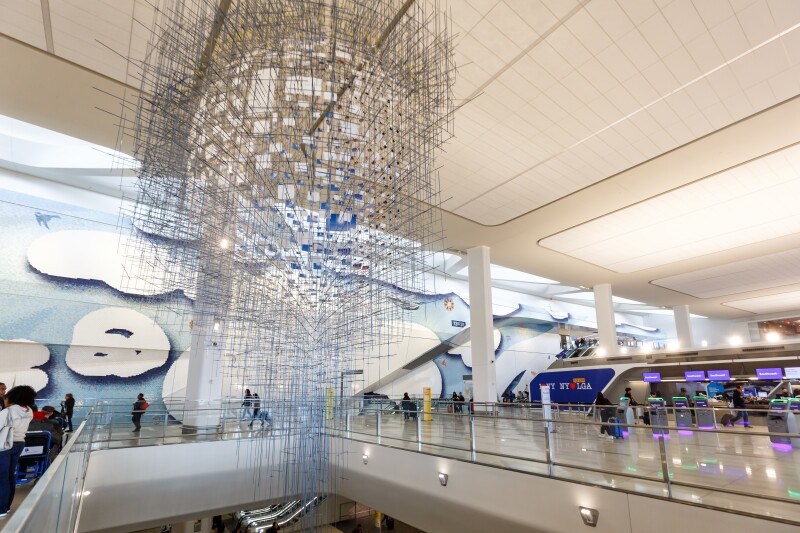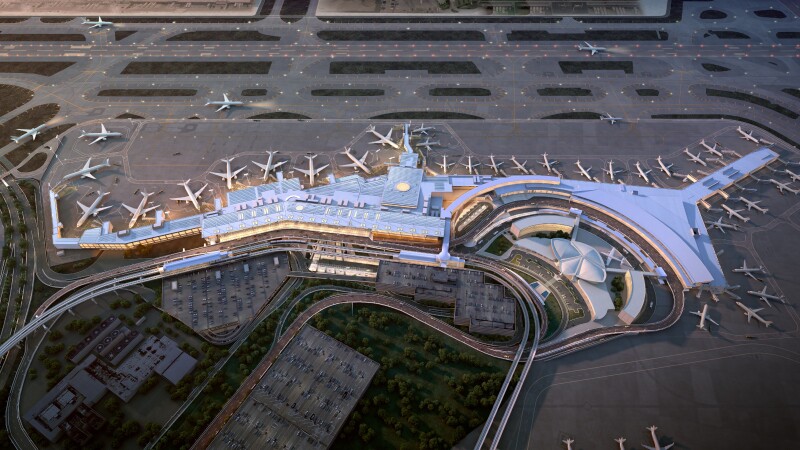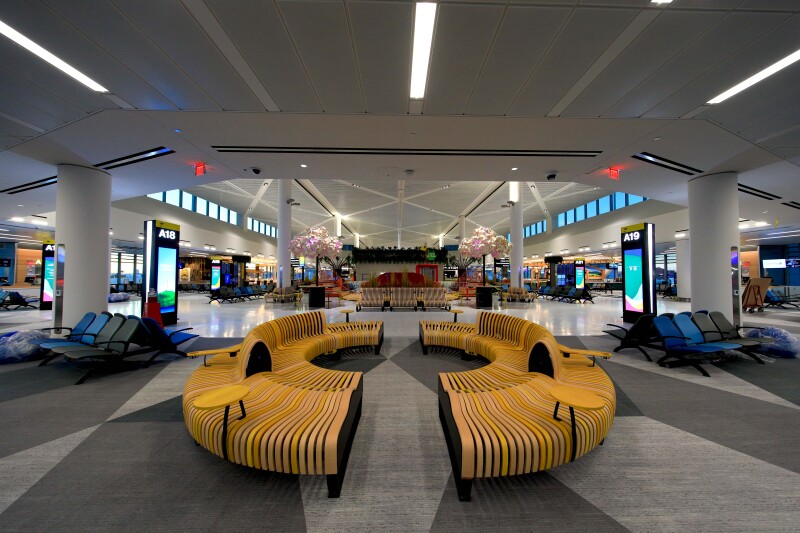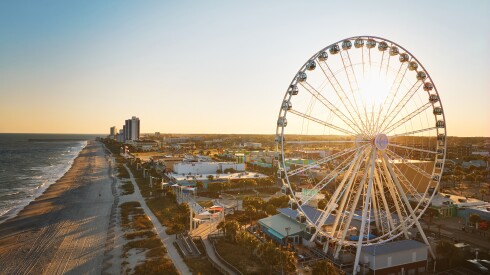New Yorkers and visitors alike are blessed with convenient air access to and from numerous points away, thanks to the fact that New York shares nonstop flights with countless major cities and smaller hubs throughout the world. And if you haven’t been to New York City in the past few years, you might be surprised to find entirely new terminals, concourses, and modernization projects that have and are continuing to completely transform the three major hubs that serve the New York City area.
Which airports serve the New York City area?
Three major airports serve the New York City area:
- LaGuardia Airport (LGA)
- John F. Kennedy International Airport (JFK)
- Newark Liberty International Airport (EWR)
There are benefits and drawbacks to flying into and out of each of these airports from a passenger’s perspective, including the distance from Manhattan and the relative ease—or lack thereof—of getting to each.
All three airports have been undergoing massive updates, including an entirely new Terminal A that recently opened at Newark, a $19 billion overhaul of JFK that will completely transform the airport in the coming years, and such significant upgrades to LaGuardia that it has evolved from the butt of the air travel jokes to winning awards for its terminal enhancements.
Here’s what travelers should know about each of the three main New York airports.

Anyone who hasn’t flown through LaGuardia in a few years, might not recognize this completely transformed New York airport.
Shutterstock
LaGuardia Airport: The airport closest to New York City is the new front-runner
If you’re flying domestically to or from New York, LaGuardia Airport could be your best bet. Between a recent game-changing transformation and its proximity to Manhattan, LaGuardia has definitely risen in the ranks among New Yorkers as a preferred travel hub.
Located in the New York borough of Queens, LaGuardia Airport (LGA) is not only the closest airport to Manhattan, but it also recently underwent substantial upgrades and now features brand-new terminals and passenger gates that have turned this former underdog (once likened to a “third-world country” facility) into an award-winning hub.
Because of its “perimeter rule,” which caps most nonstop flights to and from the airport at a distance of 1,500 miles, LaGuardia can’t be a world-class international airport on par with JFK or Newark. But for domestic flights, especially with Delta Air Lines (which has made huge investments in its LaGuardia terminal), LaGuardia should definitely be considered.
How to get to LaGuardia Airport from Manhattan
How to get to LaGuardia by public transportation
Public transportation access isn’t LaGuardia’s strong suit. There is direct bus service on the Q70-SBS from the E, F, M, and R subway trains at Jackson Heights–Roosevelt Avenue or from the 7 at the 74th Street–Broadway subway station. From the Long Island Rail Road (LIRR) train, travelers can connect to the Q70-SBS LaGuardia Link from the Woodside station. Those riding Metro–North can transfer to the M60-SBS bus at the Harlem 125th Metro–North Station to get to LaGuardia Airport. But most tourists—hard-core budget travelers notwithstanding—will simply opt for a rideshare, taxi, or paid van service.
How to get to LaGuardia by taxi or rideshare service
The most common option is a taxi or rideshare service. It’s about a $30 to $45 taxi ride from Manhattan to the airport (and vice versa), not including tolls or tip, and it takes from around 40 minutes with no traffic up to one hour during peak hours. Thankfully, the rideshare experience has become more convenient at LaGuardia; there’s a dedicated pickup area for each terminal. Passengers call for their car and walk over to a designated parking spot to meet their driver—it works pretty well. At press time, it cost in the range of $45 to $65 for an Uber or Lyft between Manhattan and LaGuardia.
The best food and services at each terminal in LaGuardia
So why did LaGuardia have such a bad reputation? Well, up until its current transformation it was dirty, crowded, and small. Thankfully for current travelers, the airport is now much improved from its former incarnation, and passengers are benefiting from the changes. Here are some of the best ways to spend your time before your flight or during a layover at LGA.
Terminal A
The historic Marine Air Terminal dates back to the 1930s and is often a source of confusion for passengers. It’s a beautiful art deco–style terminal and the home to Frontier and Spirit. However, it’s on the other side of the airport from Terminal B and Terminal C and is not linked to those terminals in any way. At Terminal A, there are few noteworthy amenities. Restaurants include Cibo Express, Dunkin’, and Salotto, a fast-casual Italian outpost with pizzas, sandwiches, beer, and cocktails. At least getting to the gates through security is a breeze; Terminal A is often as quiet as a library.
Terminal B
The airport’s main terminal, home to American, Southwest, JetBlue, and United, among other airlines, recently completed a $4 billion overhaul that was so successful that it was dubbed the best new airport terminal globally earlier this year by aviation rankings organization Skytrax. The 1.3-million-square-foot Terminal B also received a prestigious five-star Skytrax rating. The bright and airy terminal is unrecognizable from its former cramped and decrepit digs. There’s now an impressive water fixture at the center of the terminal, along with a selection of premium airport lounges, including American Express, Air Canada, American Airlines, and United Airlines. Both Capital One and Chase will be opening their own proprietary airport lounge concepts in the coming years, to add to the existing spaces. There are plenty of decent options for food and snacks in the new space, too, including Bar Veloce, the East Village wine bar; Eli’s Essentials for bagels; Hill Country for Texas-style barbecue and fried chicken; the infamous Junior’s Cheesecake; Mulberry Street for a sit-down meal; the always reliable Shake Shack; and Sweetleaf and Beecher’s for coffee and bistro fare.
Terminal C
Delta’s brand-new LaGuardia hub recently completed a $4 billion overhaul that includes a vast and airy arrivals hall and a 34,000-square-foot Delta Sky Club, the largest in the Delta system, with capacity for 600 guests. When Terminal C fully reopens in 2024, it will feature 37 gates across four concourses. (Terminal D no longer exists as a separate terminal.) There is ample artwork throughout the terminal, including giant murals, sculptures, and digital art installations. And the culinary scene has received a welcome boost, notably from several New York City outposts, including Artichoke, known for its signature artichoke spinach pizza; Bubby’s for comfort food; Eggy Weggy for breakfast sandwiches; Chuko for ramen from Morimoto veterans; Essex Burger, of Lower East Side fame; H&H Bagels; and Bisoux, from the owners of Frenchette in the city.

A new JFK is on the way, as this rendering of the forthcoming new Terminal 6 shows.
Courtesy of the Port Authority of New York and New Jersey
John F. Kennedy International Airport: New York’s main international hub
John F. Kennedy International Airport, also known by its airport code JFK, is definitely the easiest way to get from the New York City area to destinations around the world due to the sheer number of nonstop flights available on major international carriers, such as British Airways, Turkish Airlines, Lufthansa, Delta, and American. The one major airline that doesn’t fly out of JFK is United (the airline briefly returned to JFK in 2021 following a five-year hiatus, only to then pull out again in 2022); it uses Newark as its main hub. More about that below.
JFK is in the middle of a massive $19 billion overhaul of the sprawling facility. Over the course of the ambitious project, the current number of six separate terminals will shrink to four, anchored by two new complexes at either end of the airport, in what’s being billed as “one unified Kennedy Airport.” Unfortunately, the transformation means that there will be construction-related detours and potential road delays in and around the airport in the coming months and years. But it also means that a new JFK is on the way.
Modernization efforts aside, JFK is an international hub on par with other major global airports, such as London’s Heathrow Airport, Frankfurt Airport, or Dubai International Airport. And it is one of the busiest airports in the United States. Simply walking through the terminals presents a who’s who of international airlines and a potpourri of people from around the world. It makes for fascinating people-watching.
How to get to JFK from Manhattan
How to get to JFK by public transportation
In early 2023, a new Long Island Rail Road (LIRR) terminal annex, named Grand Central Madison, opened at New York City’s Grand Central Terminal, finally making it possible to get from the centrally located Manhattan train station to JFK via train. Previously, the only LIRR option to JFK from Manhattan was out of Pennsylvania Station, farther west, which is also an option. The new LIRR train service runs seven days a week between the Grand Central Madison terminal and the Jamaica stop in Queens, where travelers can transfer to JFK’s AirTrain. A train ticket between Grand Central and Jamaica costs between $7.75 and $10.75, depending on peak or off-peak times.
JFK’s AirTrain is $8 for those starting or ending their journey at the Jamaica stop.
Alternatively, travelers can also take the A subway line out to the Howard Beach–JFK Airport stop and then connect to the AirTrain. But this will be about 45 minutes longer and makes at least a dozen stops between JFK and Manhattan. Our advice is to take the LIRR if you’re keen on using public transportation.
Note that, due to ongoing construction until late 2023 or early 2024, the AirTrain’s Terminal 1 station is temporarily closed; instead, a shuttle bus is transferring passengers to and from Terminal 4 and Terminal 8, where they can pick up the AirTrain, which will add some time to the journey.
How to get to JFK by taxi or rideshare service
Traveling by car highlights the biggest drawback of JFK; it is 15–20 miles outside Manhattan, which wouldn’t be so bad if it weren’t for the all-too-common traffic along the way. And you can definitely expect to hit some unless you’re going to or from the airport after 10 p.m. at night or early in the morning before 7 a.m. When there is no traffic, the drive is about 45 minutes, but during most of the day and evening, passengers should figure on a 75- to 90-minute car ride to or from Manhattan. The flat rate taxi fare from JFK to Manhattan via a classic yellow cab is $70 (if you include the surcharge that is added during peak periods, it’s $75), not including tolls and tips. From Manhattan to JFK, however, you’re paying whatever the meter indicates for a 90-minute trip plus tolls and tip, which could set you back considerably more.
Rideshares via Uber and Lyft can be a bit less pricey in off-hours but also are subject to peak pricing surcharges, which can push the tab to over $100.
Those flying JetBlue out of Terminal 5 should note that due to the construction at Terminal 6 next door, which could last months, the taxi stand has been moved farther from the main facility to the ground level of the Yellow parking garage, and rideshare services have been relocated to the roof of the Orange garage, one AirTrain stop away at Terminal 7.
How to get to JFK by car
If you’re driving your own car, there are plenty of spots in long-term parking lots with a maximum fee of $20 a day versus up to $42 a day to park in short-term lots closer to the terminals. You can check how full the lots are before leaving home, or plan ahead and prebook parking online. All on-airport parking lots, including long-term, are connected to terminals via the free JFK AirTrain. If you’re going by road, try to time your departure to avoid the worst of the rush hour traffic—typically from 6 a.m. to 9 a.m. and from 4 p.m. to 7 p.m. on weekdays.
How to get to JFK by paid van service
There is a smattering of van services between JFK and Manhattan, a great way to save money but not time. Airlink NYC and ETS Airport Shuttle are two of the main van services authorized to operate on-site at JFK. Fares start at $40 one-way between JFK and the Grand Central train station in midtown Manhattan, which is a good deal, particularly if you have a lot of luggage and don’t mind sharing a ride and experiencing multiple stops at various hotel drop-offs or pickups along the route.
How to get to JFK by helicopter
The absolute fastest way is via Uber or Blade helicopter service, which spends about 10 minutes in the air flying between a helicopter pad in Manhattan and a private terminal at JFK. It starts at about $200 for an Instagram-ready seat. When you factor in surge pricing for rideshare service, this actually isn’t that bad of a deal.
The food and services at each terminal in JFK
Depending on which terminal you’re in, you’ll either have ample options or pretty slim pickings for things to do before your flight or during a layover. JFK consists of a (sometimes confusing) set of six terminals, numbered 1 through 8—terminals 3 and 6, built by Pan Am and National Airlines, respectively, were demolished a decade ago. Here is a breakdown of what to expect in every terminal, each of which has its own distinct features and design.
Terminal 1
The main airline tenants in Terminal 1 are Air France, Japan Airlines, Korean, Lufthansa, and Turkish. So, it’s not surprising the duty-free shopping is first rate, with brands like Bulgari and Cartier on offer. If you can gain access, the T1 airline lounges provide a posh place to escape for business- or first-class passengers. Otherwise, there’s also a Primeclass lounge for Priority Pass members. The dining is mostly fast food, but some reliable options include the Local, which serves American standards like burgers and pizza; Martini Bar for a preflight cocktail; Eat & Go Istanbul for Turkish fare; and JikJi Café with a Korean and Japanese menu.
Terminal 2
Delta is the only airline operating here and given that the airline is slated to move all of its operations to the larger Terminal 4 next door in the near future, the amenities are modest—a few fast-food venues, a Starbucks, and some convenience stores. At least there is a Delta Sky Club.
Terminal 3
This terminal no longer exists—it was demolished. The same goes for Terminal 6.
Terminal 4
The vast and airy newer Terminal 4 space boasts dozens of high-end shops and restaurants, lounges, and even a valuable private art collection. International airlines ranging from Air India to Emirates and Virgin Atlantic operate from this terminal alongside Delta (with a new Delta Sky Club), which flies both domestic and foreign flights from here. In Terminal 4, travelers will find cult fast-casual burger joint Shake Shack, the Palm Bar & Grille serving hearty steakhouse fare, and wine bar Le Grand Comptoir.
Terminal 5
This terminal has a modern design, and it’s JetBlue’s home. There’s a Ron Jon Surf Shop (purveyor of swimwear and resort apparel), sports souvenirs at WFAN 66, and two bookstores—Heritage Books and WhereTraveler. The above-average food court in the airy central plaza is an attractive option for quick to-go grub; for sit-down restaurants, you can opt for 5ive Steak, for steaks, burgers, and sandwiches; Japanese spot Deep Blue Sushi; or AeroNuova, for Italian pastas and meatball sandwiches.
Terminal 7
The first JFK terminal to be anchored by a foreign airline, British Airways, Terminal 7 is also home to Air Canada, Alaska, Condor, Iberia, Icelandair, Norse Atlantic Airways, and Scandinavian Airlines, among several others. Lounges here include BA’s first-class Concorde room with a champagne bar plus a business-class lounge. There’s also Alaska’s stylish refuge with food and beverage offerings inspired by its Pacific Northwest roots. The rest of the terminal’s food choices are decidedly less inspiring, with a Dunkin’, Le Grand Comptoir wine bar, and True Burger for those seeking a preflight bite.
Terminal 8
American Airlines and Oneworld partners like Finnair are the main tenants here. American Airlines’ Flagship Lounge and Admirals Club are available for club members and premium passengers. Head to Bobby Van’s, a New York–style wood-paneled steakhouse that also offers a wide array of sandwiches and salads and the best sit-down dining option in the terminal.

The TWA Hotel’s 1958 Lockheed Constellation “Connie” airplane has been transformed into a cocktail lounge.
Courtesy of TWA Hotel/David Mitchell
JFK’s TWA Hotel
One of the buzziest features of JFK is the throwback glamour of the TWA Hotel, which first opened in 2019. The formerly abandoned midcentury terminal turned hotel is near JetBlue’s Terminal 5. It sports a rooftop pool with runway view, a cocktail lounge inside a restored Lockheed Constellation L-1649A airplane (aka “Connie”), a sprawling sunken lounge that was restored to its original 1962 glory, and the Paris Café, a restaurant by Jean-Georges Vongerichten (who has Michelin cred and is behind Jean-Georges and ABC Kitchen in Manhattan). The TWA Hotel is like stepping back in time and is worth popping into for a meal or a drink or staying overnight in the midcentury-inspired rooms if you need a place to crash before or after your flight. We’d take hanging out at the TWA Hotel over many lounge experiences at JFK.

A brand-new, sparkling Terminal A is now open at Newark.
Courtesy of the Port Authority of New York and New Jersey
Newark Liberty International Airport: United’s main New York City area digs
If you’re flying with United or a United partner airline, you’ll be flying out of Newark, which is the main hub for United Airlines in the New York area. But there are other reasons to consider this airport. It’s not that difficult to reach with public transportation, as detailed below, and it offers a fair amount of international service, minus some of the chaos of the more popular international hub JFK. Sure, security lines can get pretty long during peak travel times at Newark, too. But 43.6 million passengers traveled through Newark in 2022, according to the Port Authority of New York and New Jersey, compared with the 55.3 million passengers who traveled through JFK during the same period. So, getting through Newark is usually a bit easier.
Newark Liberty International Airport has also recently benefited from some major renovations, namely a completely reborn Terminal A, which opened in early 2023. The much-needed new terminal, with its high ceilings and light-filled concourses, is a welcome departure from its dowdy predecessor, which has a date with a wrecking ball in the near future. The spacious gate areas now feature colorful artworks, 60 percent more seating capacity, and charging stations at each gate, among numerous other upgrades. Newark also has plans to upgrade its entire AirTrain system for getting around the airport.
How to get to the Newark airport from Manhattan
How to get to Newark by public transportation
Travel to Newark by train is quite good by New York standards. From New York’s Penn Station, you can get to Newark Liberty International Airport Station with a New Jersey Transit train. It’s about a 25-minute trip and costs about $15 per person. Unfortunately, you can’t use a Metrocard or other MTA passes on NJ Transit trains. You then transfer to the free AirTrain, which stops at each terminal. The entire trip from Manhattan is about one hour, including transit to New York’s Penn Station.
How to get to Newark by shuttle service
Airlink NYC and ETS Airport Shuttle are among the companies that operate shuttles between Manhattan and Newark, with rates starting at around $40 per person.
How to get to Newark by taxi or rideshare
Over the past few years, United Airlines has been trumpeting that it is actually much faster to get from Manhattan to Newark than to JFK. (The airline used real-time taxi data in a creative campaign.) And it’s true. A ride to or from Newark is typically between 30 minutes and one hour. That said, taxi rides and rideshare services to Newark are expensive. Your fare from Manhattan can run upwards of $100, plus a surcharge and a charge for the return tolls paid by the taxi. That can add up.
The food and services at each terminal in Newark
Terminal A
This new $2.7 billion facility is expected to be able to handle nearly 14 million passengers annually (the previous terminal was designed to handle 9 million), with 33 gates spread out over 1 million square feet. Airlines operating here include Air Canada, American, Delta, JetBlue, and United. In the new space, a central rotunda features a food court and a cluster of digital towers that honor important figures in New Jersey’s history. Concessions include locally themed eateries like New Jersey Mike’s Subs; Playa Bowls, which serves açai and poke bowls, smoothies, and juices; and Jersey & Co. Gelato, alongside popular national brands like Shake Shack and Starbucks. The ample retail stores feature major brands like Boss, MAC, Kiehl’s, and Tumi. There are also several play areas for children, and four airport lounges: an American Admirals Club, a Delta Sky Club, a United Club, and an American Express Centurion Lounge.
Terminal B
This is the main international terminal—except for United flights. It has lounges for Delta, British Airways, and other international carriers, or head to Malone’s Fish Market for healthy options, such as fish and a selection of salads, or Sora Japanese Cuisine & Sushi Bar, which has decent ramen.
Terminal C
This is the home of United Airlines and offers some of the best food options at Newark. For example, the sushi restaurant Tsukiji Fishroom serves fish that comes directly from Japan a few times per week. There’s a wood-burning grill at the terminal’s Daily restaurant (that’s its name), which has a menu that changes—you guessed it—daily. There’s an Eggy Weggy for breakfast standards that transitions into a Custom Burger at night. Garden State Diner offers up a solid Jersey diner experience. A Melange Café Bakery Chocolatier features cookies and other sweets that hail from the universe of chocolatier Jacques Torres. And there are ample additional options.
This story was originally published in January 2020 and has been updated to include current information. Barbara Peterson and Chris Dong contributed reporting.








